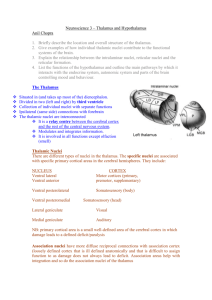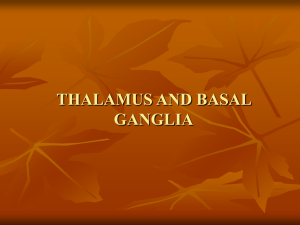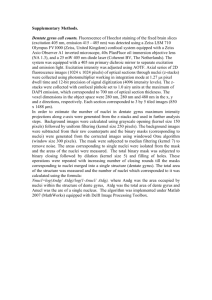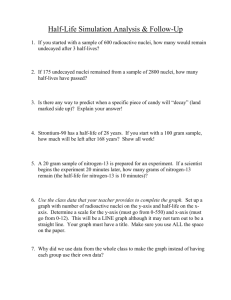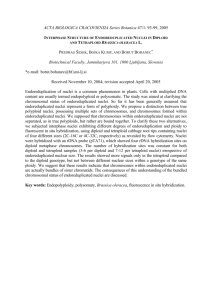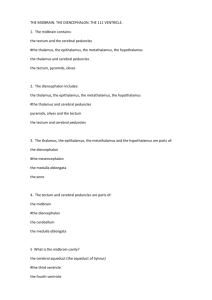DIENCEPHALON the function: 1. main subcortical sensory centre 2
advertisement
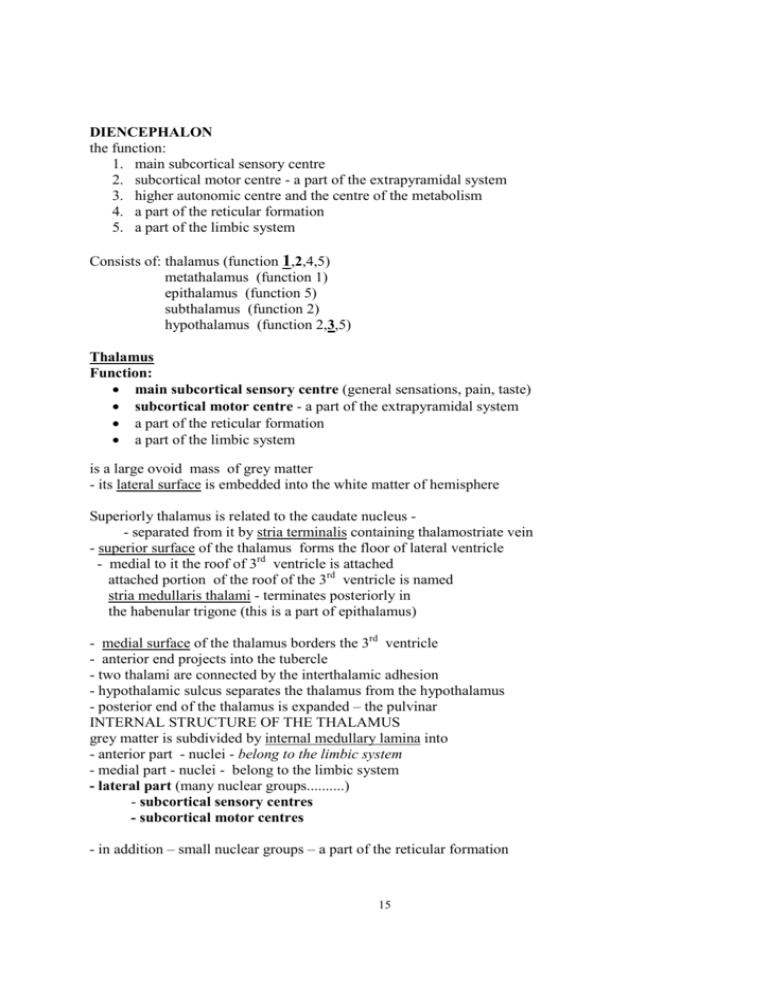
DIENCEPHALON the function: 1. main subcortical sensory centre 2. subcortical motor centre - a part of the extrapyramidal system 3. higher autonomic centre and the centre of the metabolism 4. a part of the reticular formation 5. a part of the limbic system Consists of: thalamus (function 1,2,4,5) metathalamus (function 1) epithalamus (function 5) subthalamus (function 2) hypothalamus (function 2,3,5) Thalamus Function: • main subcortical sensory centre (general sensations, pain, taste) • subcortical motor centre - a part of the extrapyramidal system • a part of the reticular formation • a part of the limbic system is a large ovoid mass of grey matter - its lateral surface is embedded into the white matter of hemisphere Superiorly thalamus is related to the caudate nucleus - separated from it by stria terminalis containing thalamostriate vein - superior surface of the thalamus forms the floor of lateral ventricle - medial to it the roof of 3rd ventricle is attached attached portion of the roof of the 3rd ventricle is named stria medullaris thalami - terminates posteriorly in the habenular trigone (this is a part of epithalamus) - medial surface of the thalamus borders the 3rd ventricle - anterior end projects into the tubercle - two thalami are connected by the interthalamic adhesion - hypothalamic sulcus separates the thalamus from the hypothalamus - posterior end of the thalamus is expanded – the pulvinar INTERNAL STRUCTURE OF THE THALAMUS grey matter is subdivided by internal medullary lamina into - anterior part - nuclei - belong to the limbic system - medial part - nuclei - belong to the limbic system - lateral part (many nuclear groups..........) - subcortical sensory centres - subcortical motor centres - in addition – small nuclear groups – a part of the reticular formation 15 - intralaminar nuclei - reticular nucleus - midline nuclei - pulvinar nuclei - posterior part - pulvinar nuclei – limbic system CONNECTIONS OF THALAMUS thalamus is involved in activities of all major regions of the CNS: - whole sensory system (except olfactory) - cerebral cortex - basal nuclei - cerebellum - reticular formation all project to the thalamic nuclei and most receive reciprocal thalamic connection 1. Lateral part of thalamic nuclei (neothalamus) subcortical sensory and motor centres afferents: from the lower sensory centres: - spinothalamic - medial lemniscus - trigeminal lemniscus - solitariothalamic tract efferents: to the cortex - sensory area afferents from the subcortical motor centres: - basal nuclei - cerebellum - red nucleus Efferents - to the motor area - to the other subcortical centres 2. Anterior and posterior part (paleothalamus) is included in the limbic system 3. Medial part (paleothalamus) takes part in the integration of visceral and somatic activities afferents and efferents: - hypothalamus - frontal cortex - basal nuclei 4. Intralaminar, reticular, midline nuclei represent thalamic reticular system afferents: from the reticular formation efferents: to the cerebral cortex Metathalamus F: main subcortical sensory centre (visual, auditory) 16 Medial geniculate body – the subcortical auditory centre (is connected with the inf. colliculus by the brachium of inf. coll.) afferents: from the lateral lemniscus (auditory pathway) efferents: to the temporal cortex – the cortical (higher) auditory centre (acoustic radiation) Lateral geniculate body – the subcortical visual centre (is connected with the sup. colliculus by the brachium of sup. coll.) afferents: from the optic tract (larger portion) efferents: to the occipital cortex (optic radiation) Epithalamus F: a part of the limbic system comprises: habenular trigone habenular commissure pineal body posterior commissure habenular trigones contain habenular nuclei afferents: from olfactory centres (some fibres are crossed in the habenular commissure) efferents: to the reticular formation and autonomic centres Mediate autonomic response to the olfactory stimuli Subthalamus F: subcortical motor centre - a part of the extrapyramidal system contains subthalamic nucleus – shaped like biconvex lens zona incerta – a narrow plate of grey matter afferents: - from cortex - basal nuclei - thalamus efferetns: to - the red nucleus - reticular formation - hypothalamus Hypothalamus F: • higher autonomic centre and the centre of the metabolism • subcortical motor centre - a part of the extrapyramidal system • a part of the limbic system forms the floor of the 3rd ventricle externally comprises: mamillary bodies - contained grey matter is a part of the limbic system 17 tuber cinereum – is placed in front of the mamillary bodies, contains tuberal nuclei infundibulum – pituitary gland is attached to it internal structure: grey matter of the hypothalamus is subdivided into: 1. anterior hypothalamic region – contains supraoptic and paraventricular nuclei – produce neurohormons oxitocin and adiuretic hormon 2. intermediate hypothalamic region – contains tuberal nuclei – influence secretion of all the hypophysial hormons 3. lateral hypothalamic region – contained grey matter represents some control centres of the metabolism 4. posterior hypothalamic region – contained mamillary nuclei are involved in the limbic system connections of the hypothalamus: afferents: from the reticular formation of midbrain from the thalamus (somatosensory and viscerosensory fibres) from the basal nuclei from the olfactory area (to the mamillary nuclei) efferents: to the cortex to the reticular formation and to the lower autonomic centres - parasympathetic nuclei in the brainstem (cranial nerves nuclei) and - sympathetic and parasympathetic nuclei in the spinal cord to the thalamus to the basal nuclei to the pituitary gland – hypophysis – hypothalamohypophysial tract Hypothalamohypophysial tract: is represented by the axons of nerve cells contained in some hypothalamic nuclei axons terminate in the hypophysis 1. supraoptic and paraventricular nuclei – send the axons to the neurohypophysis – neurohormones (adiuretic and oxitocin) are conveyed and released to the capillaries in the neurohypophysis 2. tuberal nuclei send the axons transporting special substances to the infundibule. The substances are released to the capillaries contained in the infundibule. The substances releasing and inhibiting the secretion of adenohypophysial hormones are transported to the adenohypophysis via hypophysial portal venous system. Hypophysial portal venous system – serves for the transport of releasing and inhibiting substances from the infundibule to the adenohypophysis. It is represented by two capillary networks connected by thin veins – hypophysial portal veins. One capillary nettwork is located in the infundibule, the other in the anterior lobe. 18

